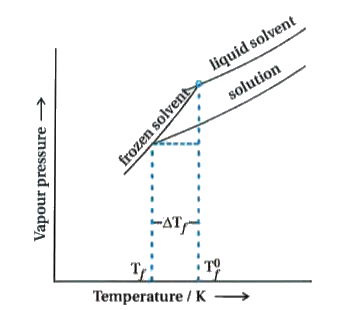InterviewSolution
Saved Bookmarks
| 1. |
What is molal depression constant (K_(f)) ? Derive equation relating K_(f) with molar mass of solute. |
|
Answer» SOLUTION :Decrease in freezing point of a solution prepared by dissolving one gram molar mass of non - volatile solute into one kilogram of solvent is called MOLAL depresion constant. Let `T_(f)^(0)` be the freezing point of PURE solvent and `T_(f)` be its freezing point when non - volatile solute is dissolved in it. The decrease in freezing point. `Delta T_(f)=T_(f)^(0)-T_(f)` is known as depression in freezing point. For dilute solution (ideal solution) is directly PROPORTIONAL to MOLALITY, m of the solution. Thus, `Delta T_(f)prop m` `Delta T_(f)=K_(f).m ""`....(i) The proportionality constant `K_(f)`, which depends on the nature of the solvent is known as Freezing Point Depression Constant or Molal Depression Constant or Cryoscopic Constant. The unit of `K_(f)` is K kg `mol^(-1)`.  If `w_(2)` gram of the solute having molar mass as `M_(2)`, present in `w_(1)` gram of solvent, produces the depression in freezing point `Delta T_(f)` of the solvent then molality of the solute is given by the equation. `m=(w_(2)//M_(2))/(w_(1)//1000)` Substituting this value of molality in equation (i) we get, `Delta T_(f)=(K_(f)xx w_(2)//M_(2))/(w_(1)//1000)` `Delta T_(f)=(K_(f)xx w_(2)xx1000)/(w_(1)xx M_(2))` `M_(2)=(K_(f)xx w_(2)xx 1000)/(Delta T_(f)xx w_(1))` |
|